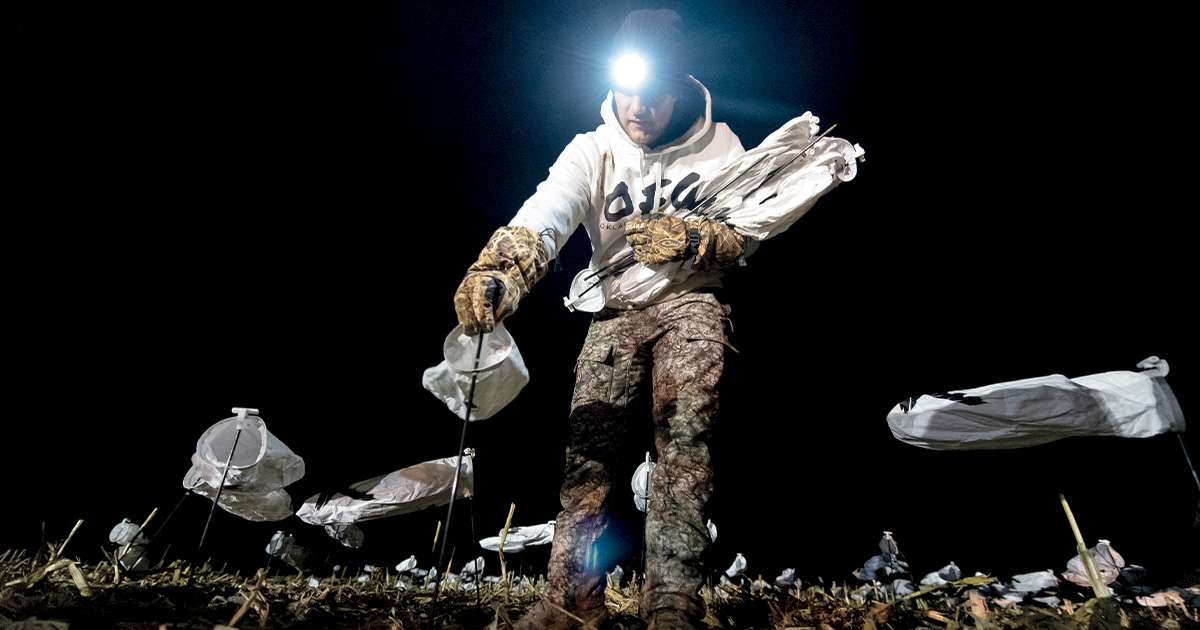Waterfowler's World: Small-Spread Snows
It doesn't take a trailer full of gear to be a successful snow goose hunter
It doesn't take a trailer full of gear to be a successful snow goose hunter

By Bill Buckley

Wind socks are a great option for beginning snow goose hunters. These lightweight decoys take up little storage space, can be deployed quickly, and look remarkably lifelike in the field.
Unlike what you might have gleaned from watching online videos, snow goose hunting needn’t be a test of endurance, requiring massive spreads and 3:00 a.m. wake-up calls. Nor do you have to spend a fortune to get into the sport. As my friend Andy Farrell proves year after year, you can fit everything you need in the bed of a pickup truck and still have plenty of gas money for scouting. Here’s a quick rundown of Farrell’s system.
Wind socks are Farrell’s decoys of choice. They’re inexpensive, durable, and quick to set up. Most companies offer less-expensive “headless” wind socks, which Farrell says work just fine. Wind socks move in the slightest breeze, creating the illusion of a feeding flock. Another advantage is that most compress down to almost nothing, allowing over 10 dozen to fit in one wind sock bag. Speaking of 10 dozen, Farrell recommends that number as a good starting point. As for flyers and mechanized contraptions that imitate landing snows, he says he would rather spend his money on more wind socks. He does, however, use one flyer on a retractable crappie pole as a goose flag.
The key to a small spread’s effectiveness is having a large footprint. Farrell, who often hunts alone, usually sets out 300 wind socks (which takes him less than an hour) and will typically start his spread 100 yards downwind of where he’ll be set up. “I’ll set a loose line of family groups at the bottom of the spread to channel the geese into the pocket where I want them to land,” he explains. “Ideally, I’ll be set up directly upwind of a roost. If the roost is off to one side, I’ll skew the line in that direction, again to funnel them toward the center of the upwind portion of the spread. Within the family groups I’ll place decoys roughly 2 to 3 yards apart and have 6 to 8 yards between groups. The bottom of my spread averages 20 to 30 yards wide.
“Closer to my landing pockets, I’ll tighten up the spacing. Approximately 40 percent of my decoys will be in the top quarter to third of the spread, and the outer decoys will be about 20 yards from each shooter. That way, if geese decide to land on the outside edge, you can still get clean kills. Also, unless it’s really windy and the geese are on the deck, I’ll have very few decoys behind me—to prevent them from trying to land there.”
Many snow goose hunters set their layout blinds tight together and place lots of tall-staked decoys around the blinds to help hide them—creating a so-called “white stripe.” Farrell recommends separating hunters by 10 yards or so and using fewer decoys around each gun. “In huge spreads, that dense white stripe may hide hunters, but getting snows to decoy consistently requires a subtler approach,” he says. “I use a headrest and pad and either a ghillie suit or blanket in conjunction with fewer than a dozen longer-staked decoys per gun. That’s plenty of cover to have geese landing within feet of you.”
When and where it’s legal, Farrell uses a high-end FOXPRO digital call, which he keeps on low volume unless he’s trying to turn passing flocks. Since snows, like Canadas, are very sound-oriented, he’ll place the speakers right where he wants the birds to land. Good handheld calls are certainly effective, but they don’t have nearly the same impact, particularly on larger flocks or when you’re trying to turn birds.
Don’t expect to set up in just any field and attract birds, even on migration days. Small spreads are far more effective when geese have been staying in one area for a while, either in the fall, before harsh weather pushes them south, or in the spring, when they hit snow lines. In these situations, you’ll have more opportunity to pattern them and locate fields they’re feeding in. “I know it’s a cliché,” Farrell says, “but the more time you scout, the more successful you’ll be. It’s as simple as that.”
Ducks Unlimited uses cookies to enhance your browsing experience, optimize site functionality, analyze traffic, and deliver personalized advertising through third parties. By continuing to use this site, you agree to our use of cookies. View Privacy Policy